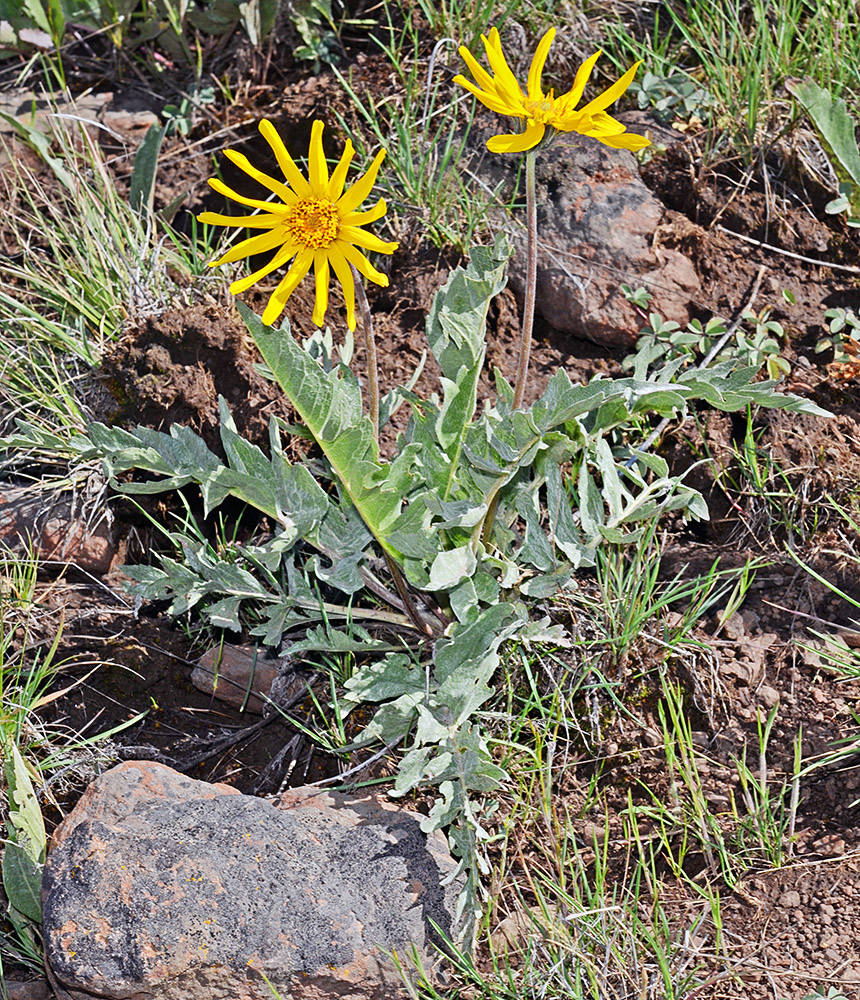Balsamorhiza macrophylla
Balsamorhiza incana
large-leaf balsamroot
hoary balsamroot, woolly balsamroot
up to 35 cm, tomentose; from single taproot.
9–43 cm, tomentose; from single taproot.
lanceolate-oblong, 1-pinnately divided;
pinnae toothed, with teeth only on lower margins;
surfaces tomentose;
basal leaves in 1–few rosettes;
blades 12–22 × 6–8 cm;
pinnae 10–36 mm wide;
petioles 7–20 cm;
cauline blades 1.5–5 × 0.3–0.9 cm;
petioles 6–9 cm.
ovate-lanceolate, 1-pinnately divided;
margins toothed, especially distally, sometimes also on proximally;
surfaces tomentose and often lacking glands;
basal leaves in 1–few rosettes;
blades 11–22 × 5–8.5 cm;
pinnae 5–15 mm wide;
petioles 4–17 cm;
cauline leaves in 1 pair, sometimes very near base of stem;
blades 1.5–9.5 × 0.6–4.5 cm;
petioles 4–8 cm.
with 1 terminal head.
with 1 terminal head.
14–18 × 25–30 mm.
11–18 × 18–28 mm.
14–16, yellow;
rays 35–40 × 8–11 mm.
deciduous, 13–22, yellow;
rays 25–35 × 7–10 mm.
~9 mm.
7.5–9 mm.
ovate-lanceolate, 20–25 × 5–6 mm;
tips acuminate, tomentose.
lanceolate, 15–20 × 3–5 mm;
tips acuminate.
8–9 mm, glabrous.
5–6 mm, glabrous.
10–12 mm.
~10 mm.
=100 ± 2.
=38.
Balsamorhiza macrophylla
Balsamorhiza incana
Dry, open areas. Flowering May–Jul. 700–1400 m. BW. ID; east to WY. Native.
True B. macrophylla is a decaploid centered on the Wasatch Mountains in Utah and Idaho. The plants in Oregon and western Idaho are also high polyploids, but they differ morphologically from classic B. macrophylla in their denser pubescence and the shape of their leaves. These eastern plants have been given the name B. macrophylla var. idahoensis. However, further study will likely show that they have a different parentage than B. macrophylla s.s. The specific epithet “macrophylla” means large-leaved, as the leaves are much larger than those of the other members of section Balsamorhiza.
Open, rocky areas. Flowering Apr–Jun. 300–1500 m. BW, Col. ID, WA; east to WY. Native.
Balsamorhiza incana is unusual among species of section Balsamorhiza in remaining fairly distinct throughout its wide range. It occurs generally north and east of the widespread B. hispidula/B. hookeri complex. Its hybrids with B. sagittata have been given the name B. × tomentosa. The specific epithet refers to the whitish appearance from the dense pubescence.
Abigail (Abby) Moore
Abigail (Abby) Moore




